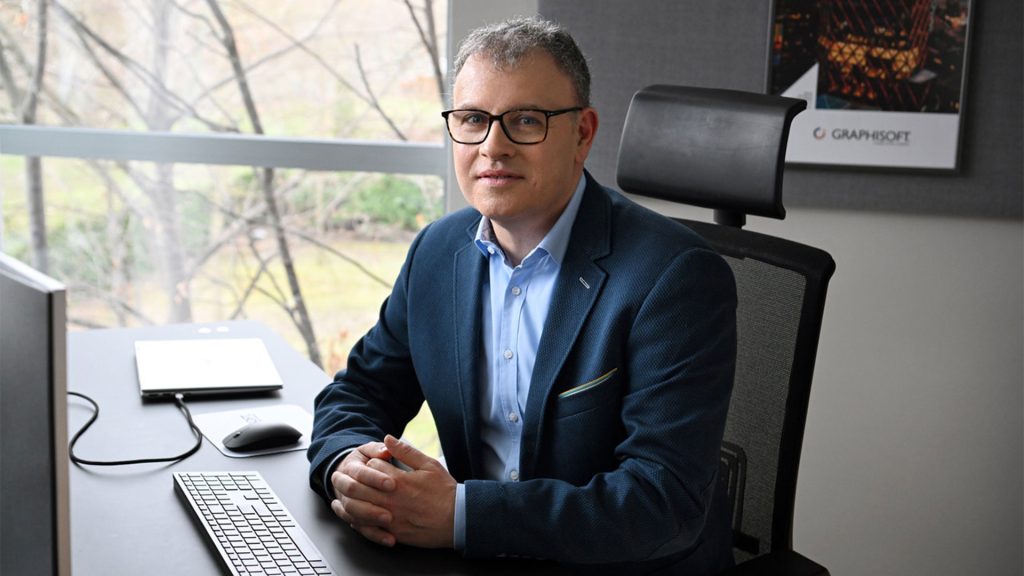In the shift from BIM to BIM 2.0, big changes are underway at Graphisoft. Martyn Day chats with new CEO Daniel Csillag about his plans for the company
To Graphisoft observers, the company’s recent CEO transition looks like one of the industry’s more abrupt handovers. In February 2024, Daniel Csillag was named as Graphisoft’s new CEO, replacing Huw Roberts, who had been in the role since 2019. The change comes hard on the heels of the earlier appointment of César Flores Rodríguez as chief division officer for planning and design and digital twin at Nemetschek Group in July 2023.
Between 2017 and 2022, Csillag was general manager of Bluebeam and CEO of Nevaris, two other Nemetschek brands. He had subsequently spent almost two years working outside of the group, in the role of chief revenue officer at Thinkproject, a cloud-based asset lifecycle platform. With these experiences under his belt, Csillag is both a Nemetschek company insider and someone with considerable experience of cloud-based SaaS offerings.
When asked whether applications should be desktop or cloud-based, Csillag takes the middle way, in keeping with Graphisoft’s hybrid view.
“The desktop is here to stay, and the desktop will probably never disappear,” he says. When he was running Nevaris, he reflects, he was dealing with a very heavy ERP and estimating solution and, even then, a desktop offering was available, even though it was based on Microsoft Dynamics.
“While the cloud was central, it will always be a hybrid solution. Customers will be able to pick a 100% cloud solution, or prefer a combination of cloud and desktop. However, it will never be desktop only anymore. Those times have gone.”
Looking at the opportunities that Graphisoft faces, one might think that the BIM market is already highly penetrated and saturated – so where does Csillag intend to focus the company?
“Selling more to the same people is certainly one option, but finding new services is another, which are very likely to be cloud-related,” he says. “If today, we discuss a product we want to develop, we don’t discuss that as a desktop application. We always discuss it in a cloud environment, because the rest of the world will slowly migrate to more cloud. related services.”
At the same time, Graphisoft is still seeing very high growth rates in particular geographies, he says. The footprint of Graphisoft is very fragmented, with a heavy footprint in some markets (particularly Germany, Austria and Switzerland), but plenty of opportunity left to exploit in the US and in southern European countries, including Spain, Portugal and Italy.
“And even in a saturated market, where users already have a solution which they work with, those users may think what we have is really great and recognise it can help them,” he adds. “Revit users take us as a second solution into their portfolio, because they can do things with Archicad that they can’t typically do with Revit. I think the combination of Revit together with Archicad works well and is getting more and more popular.”
Find this article plus many more in the Sept / Oct 2024 Edition of AEC Magazine
👉 Subscribe FREE here 👈
Market trends
In April 2024, Autodesk and Nemetschek signed an interoperability agreement to improve collaboration between their tools. This will enable Nemetschek to access Autodesk Platform Services (or APS, formerly known as Forge) and improve data flow. The concept of Archicad as a second seat might not seem so far-fetched with better integration. As Csillag comments: “We absolutely believe that the deal is helping us. It’s also helping Autodesk, because they have so much pressure for openness from their customers. At least this pressure is going away now.”
In some situations, bigger firms (50 seats, for example) may stick with Revit but purchase 10 seats of Archicad on top, he says. “And there are some markets where we really can replace other players and not necessarily always Revit,” he continues. “We have certain markets where we have significant growth potential of 20/30/40% every year. At least, we have that now. It might not be the same in five years’ time, but right now, we have that, because we are underrepresented in certain markets. Italy is a good example. We tripled our size in Italy over three years.”
Like all software companies, Nemetschek is under pressure to shift from perpetual licences to subscriptions and services. For Graphisoft customers, says Csillag, “it’s an optional choice. We are watching the market. We’re seeing how fast the transition goes, because our interest is to have an as-fast-as-possible transition, if only for the simple reason that we want to focus on one business model.”
For now, the company maintains two models, he adds, to give customers some flexibility and the opportunity to get accustomed to a new approach.
“But at a certain point in time, we really must accelerate this transition to a subscription model, and that will happen. I’m not stating that will happen tomorrow, but it will happen at a certain point, if we reach a certain transition status. For a software player in a saturated market, the classic perpetual licence model is not sustainable.”
Main image: Daniel Csillag, CEO Graphisoft






